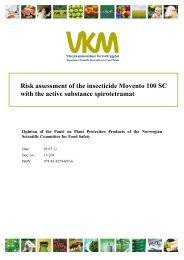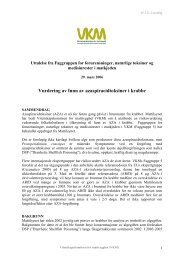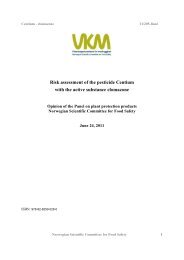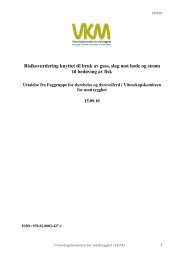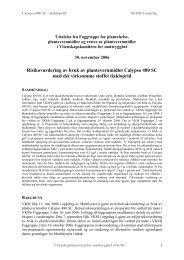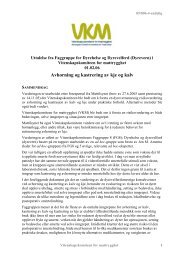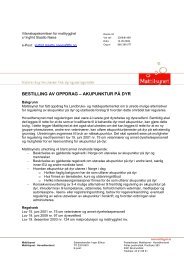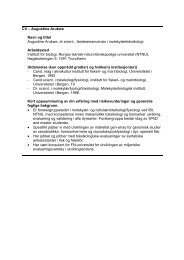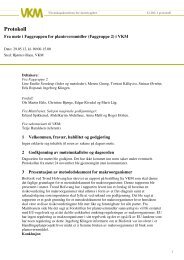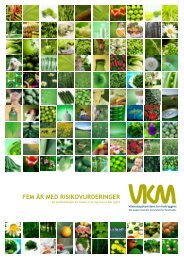Pest risk assessment of the Cucumber green mottle
Pest risk assessment of the Cucumber green mottle
Pest risk assessment of the Cucumber green mottle
Create successful ePaper yourself
Turn your PDF publications into a flip-book with our unique Google optimized e-Paper software.
07/207-4 Finaleconomic impact. Besides this, establishment <strong>of</strong> CGMMV could give a less stable supply <strong>of</strong>Norwegian cucumbers, which would influence <strong>the</strong> market situation.4.1.10 Conclusion <strong>of</strong> pest categorizationCGMMV is a highly contagious virus, which is able to spread rapidly in cucumber crops iffirst introduced. It clearly has <strong>the</strong> potential to become established in protected environmentsin <strong>the</strong> PRA area. Moreover, CGMMV will have a substantial impact for those growersaffected, even before becoming widespread and permanently established. This is partly due tochanges in cucumber production. An increasing proportion <strong>of</strong> production occurs usingintensified artificial lighting, which also seems to increase <strong>the</strong> potential <strong>of</strong> CGMMV as a plantpest.Field grown cucumbers are less handled, plant density is lower, <strong>the</strong> temperature is lower(slower plant growth and virus multiplication), <strong>the</strong> crop is only grown for about 4 months ayear, and <strong>the</strong> fields are used in a crop rotation. All this makes <strong>the</strong> probability forestablishment and damage low in comparison to <strong>green</strong>house grown cucumbers.4.2. Assessment <strong>of</strong> <strong>the</strong> probability <strong>of</strong> introduction and spread4.2.1 Probability <strong>of</strong> entry <strong>of</strong> <strong>the</strong> pest4.2.1.1 Identification <strong>of</strong> pathwaysThe following are possible pathways <strong>of</strong> entry for CGMMV:SeedsThe seeds can have infective virus particles in <strong>the</strong> seed coat. In <strong>the</strong> germination phase thismay lead to infection <strong>of</strong> <strong>the</strong> seedling. This is a well known pathway (Fletcher et al. 1969,Hollings 1975). To avoid this way <strong>of</strong> dissemination, <strong>the</strong> seed companies use heat treatment <strong>of</strong><strong>the</strong> seeds. Failure to do so, or failure in <strong>the</strong> heat treatment, may <strong>the</strong>refore lead to transmission<strong>of</strong> CGMMV virus particles from seeds to seedlings. Theoretically, it is also a possibility thatmore heat tolerant strains <strong>of</strong> <strong>the</strong> virus could evolve.Seed transmission in Lagenaria has been found in Greece (Bourbourakas et al. 2004).Infected seeds <strong>of</strong> Lagenaria or more exotic plants within <strong>the</strong> family Cucurbitaceae is apossible pathway for CGMMV in to Norway.Infected cucumber, melon or watermelonFruits <strong>of</strong> cucumber are imported into <strong>the</strong> PRA region during parts <strong>of</strong> <strong>the</strong> year, and melons andwatermelons are imported <strong>the</strong> whole year. Such fruits, if infected, could introduce CGMMVto Norway.Regarding ano<strong>the</strong>r virus, Pepino mosaic virus, <strong>the</strong>re have been indications that <strong>the</strong> virus hasentered <strong>the</strong> tomato crop via people handling infected tomato fruits as a part <strong>of</strong> <strong>the</strong>ir meal andafterwards going to work in <strong>the</strong> tomato crop.Reuse <strong>of</strong> transport trays.Transport trays used in cucumber production are normally reused. If <strong>the</strong>se trays have beenused for infected fruits <strong>of</strong> cucumber, melon or watermelons and are used again without beingproperly washed and disinfected, <strong>the</strong>y might introduce infective virus particles to newcucumber crops.Norwegian Scientific Committee for Food Safety 19



